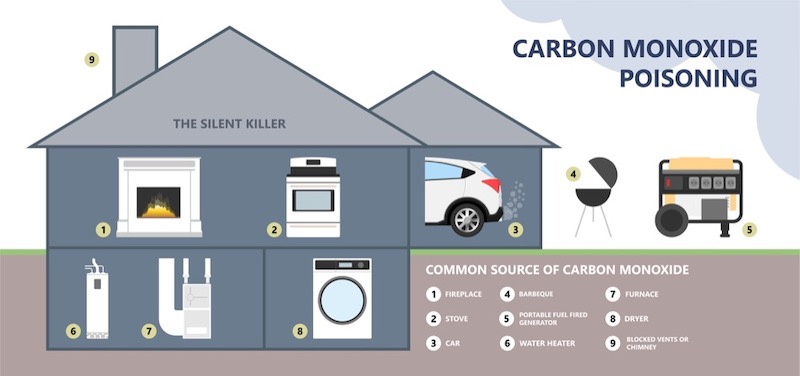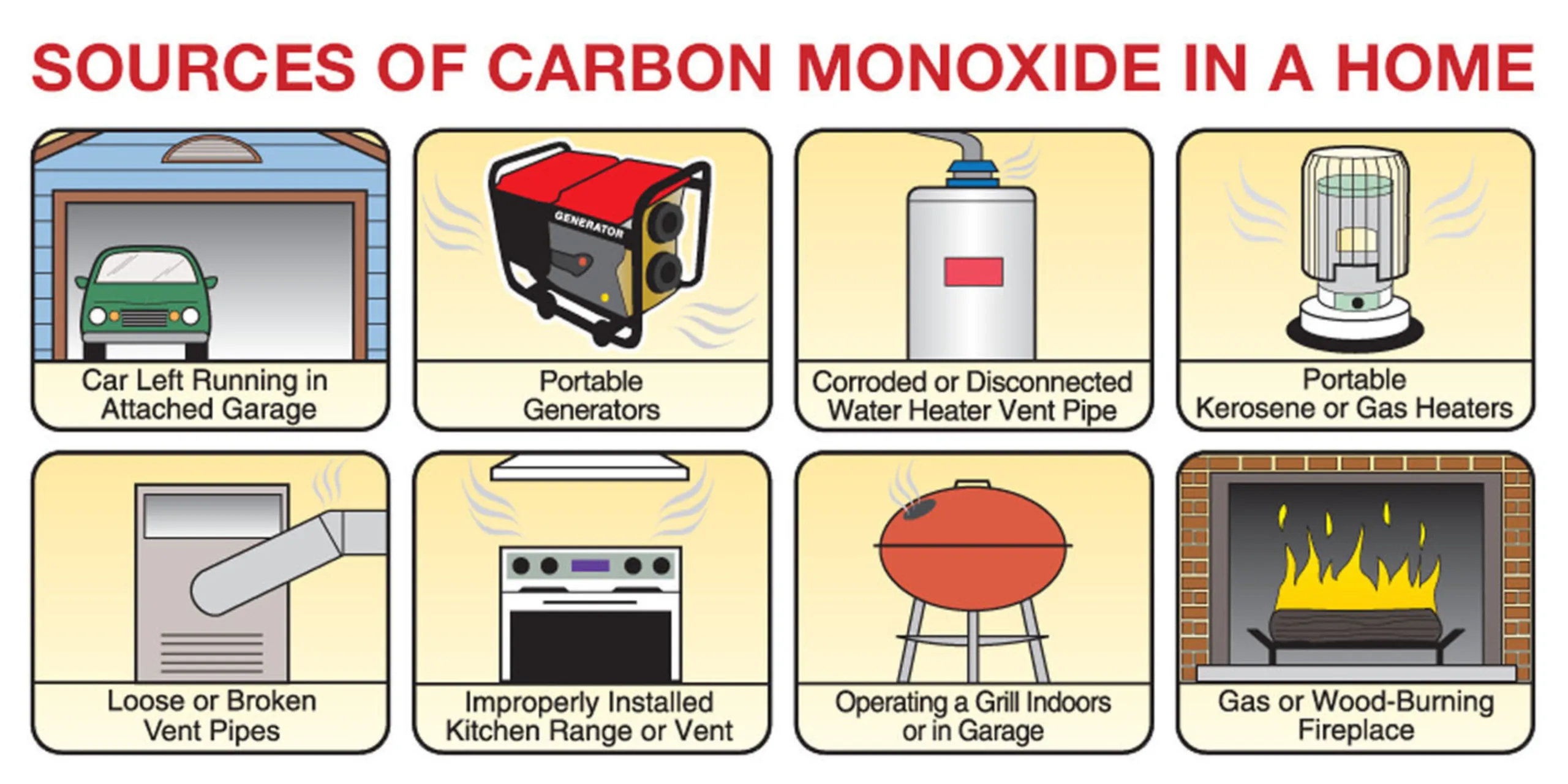What Can Cause Carbon Monoxide In A Home

Frequently Asked Questions About Carbon Monoxide in Your Home
Carbon monoxide (CO) is an invisible, odorless, and deadly gas. It's often called the "silent killer" because you can't see, smell, or taste it. Many homeowners and facility managers have questions about what causes CO in a home or building. This FAQ will answer some of the most common questions to help you stay safe.
Q1: What is Carbon Monoxide and Why is it Dangerous?
Carbon monoxide (CO) is a byproduct of incomplete combustion. This means it’s produced when fuels like natural gas, propane, wood, oil, or kerosene don't burn completely. It's dangerous because when you breathe it in, CO replaces oxygen in your bloodstream. This deprives your heart, brain, and other vital organs of oxygen, leading to serious health problems and potentially death.
Q2: What are the Most Common Sources of Carbon Monoxide in a Home?
Several appliances and devices commonly found in homes can produce CO. The most frequent culprits include:
- Furnaces: Malfunctioning or poorly maintained furnaces are a major source. Issues like cracked heat exchangers or blocked vents can cause CO to leak into your home.
- Water Heaters: Gas-powered water heaters, especially older models, can produce CO if they are not properly vented or maintained.
- Fireplaces (Wood-Burning or Gas): Incomplete combustion of wood or gas in a fireplace can release CO into the room, especially if the chimney is blocked or the damper is closed.
- Gas Stoves and Ovens: While designed for cooking, gas stoves and ovens can produce CO if not properly adjusted or ventilated. Prolonged use of the oven, especially with a low flame, increases the risk.
- Portable Generators: Never operate a gasoline-powered generator inside a home, garage, or other enclosed space. Generators produce significant amounts of CO, and even opening a window is not enough to prevent buildup.
- Vehicles: Running a car or other vehicle in an attached garage, even with the door open, can cause CO to seep into the house.
- Charcoal Grills: Similar to generators, charcoal grills should never be used indoors. They produce large amounts of CO.
- Space Heaters (Kerosene or Propane): Unvented space heaters are a significant risk factor for CO poisoning.
Q3: How Can I Tell if There is Carbon Monoxide in My Home?
Unfortunately, you can't rely on your senses to detect CO because it's odorless and invisible. The only reliable way to detect CO is with a carbon monoxide detector. These detectors are designed to sound an alarm when CO levels reach a dangerous level.
However, you should also be aware of the symptoms of CO poisoning. These can include:
- Headache
- Dizziness
- Weakness
- Nausea
- Vomiting
- Chest pain
- Confusion
- Blurred vision
- Loss of consciousness
If you suspect CO poisoning, immediately evacuate the premises and call 911 or your local emergency number from a safe location.
Q4: Where Should I Place Carbon Monoxide Detectors in My Home?
It's crucial to install CO detectors in the right locations to ensure they can effectively alert you to a potential CO leak. Here are some guidelines:
- On Every Level: Install at least one CO detector on every level of your home, including the basement.
- Near Sleeping Areas: Place detectors in hallways outside of bedrooms, as you are most vulnerable to CO poisoning while sleeping.
- Near Potential Sources: Install detectors near potential sources of CO, such as furnaces, water heaters, and fireplaces.
- Follow Manufacturer's Instructions: Carefully read and follow the manufacturer's instructions for placement, as some detectors have specific mounting requirements.
- Avoid Obstructions: Do not place detectors behind furniture or curtains, as this can block the sensor.
- Away From Extreme Temperatures: Avoid placing detectors in areas that experience extreme temperatures or humidity, such as bathrooms or near stoves, as this can affect their accuracy.
- Test Regularly: Test your CO detectors regularly, at least once a month, to ensure they are working properly. Replace the batteries according to the manufacturer's recommendations.
Remember, a properly placed and functioning CO detector can save your life.
Q5: How Can I Prevent Carbon Monoxide Buildup in My Home?
Preventing CO buildup is essential for protecting your family's health and safety. Here are some key preventative measures:
- Regular Appliance Maintenance: Have your furnace, water heater, and other gas-burning appliances inspected and serviced by a qualified professional at least once a year. This includes checking for leaks, proper venting, and any signs of damage.
- Chimney Inspection and Cleaning: Have your chimney inspected and cleaned annually to ensure proper ventilation and prevent blockages.
- Proper Ventilation: Ensure that all gas-burning appliances are properly vented to the outside. Never block or obstruct vents.
- Never Use Generators or Grills Indoors: Never operate gasoline-powered generators, charcoal grills, or propane heaters inside your home, garage, or other enclosed spaces.
- Be Careful with Fireplaces: Ensure the damper is fully open when using a fireplace. Never close the damper until the fire is completely out and the embers are cold.
- Avoid Idling Vehicles in the Garage: Never run a car or other vehicle in an attached garage, even with the door open.
- Use Appliances as Intended: Use gas stoves and ovens for cooking only. Never use them to heat your home.
- Install and Maintain CO Detectors: Install CO detectors on every level of your home and test them regularly. Replace the batteries as needed and replace the detectors every 5-7 years, or according to the manufacturer's instructions.
- Educate Your Family: Make sure everyone in your family knows the symptoms of CO poisoning and what to do if they suspect a leak.
By following these preventative measures, you can significantly reduce the risk of CO buildup in your home and protect your family from this dangerous gas.
Q6: What Should I Do if My Carbon Monoxide Detector Goes Off?
If your CO detector sounds an alarm, it's critical to act quickly and decisively. Here's what you should do:
- Evacuate Immediately: Get everyone out of the house immediately. Do not try to find the source of the CO or open windows while inside.
- Call 911 or Your Local Emergency Number: Once you are safely outside, call 911 or your local emergency number to report the alarm.
- Do Not Re-enter: Do not re-enter the house until the fire department or other qualified professionals have determined that it is safe to do so.
- Seek Medical Attention: If anyone in your family is experiencing symptoms of CO poisoning, seek medical attention immediately. Tell the medical personnel that you suspect CO poisoning.
- Identify the Source: Once the house has been declared safe, try to identify the source of the CO. Do not operate any gas-burning appliances until they have been inspected and repaired by a qualified professional.
- Contact Professionals: Contact a qualified HVAC technician or other professional to inspect your appliances and ventilation system to identify and repair the source of the CO leak.
Treat every CO alarm seriously. It's better to be safe than sorry when dealing with this deadly gas.
Q7: Are there specific regulations or requirements for CO detectors in my area?
Yes, many states and local municipalities have laws or regulations regarding the installation and maintenance of carbon monoxide detectors in residential buildings. These regulations can vary widely, so it's essential to check the specific requirements for your location.
Here's how to find information about your local CO detector regulations:
- Contact Your Local Building Department: Your local building department or code enforcement office is the best resource for information about local CO detector requirements. They can provide you with specific information about the types of detectors required, where they need to be installed, and any other relevant regulations.
- Check Your State's Department of Health or Fire Marshal's Office: Many state departments of health or fire marshal's offices also have information about CO detector regulations on their websites.
- Consult with a Qualified HVAC Technician or Electrician: A qualified HVAC technician or electrician can also advise you on the specific CO detector requirements in your area.
- Review Your Homeowner's Insurance Policy: Some homeowner's insurance policies may require CO detectors as a condition of coverage. Check your policy for details.
Compliance with local CO detector regulations is not only a legal requirement but also an important step in protecting your family from CO poisoning. Be sure to familiarize yourself with the regulations in your area and ensure that your home is equipped with the appropriate detectors.
Disclaimer: This information is for general knowledge purposes only and does not constitute professional advice. Always consult with qualified professionals for specific advice related to your situation.








:max_bytes(150000):strip_icc()/carbon-monoxide-poisoning-3885555_final-4f1e13cc579241aeaee6df0d8d24eb8b.png)

